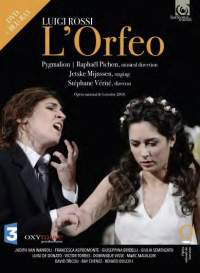Texte paru dans: / Appeared in: |
|
|
Outil de traduction ~ (Très approximatif) |
|
|
Reviewer: John
W.Barker Luigi Rossi (1597-1653) was one of the bright lights of music in Rome in the early 17th Century, most famous for his cantatas. Since opera was denied public performances in Papal Rome, he was able to produce only one there, under the private patronage of the Barberini family in 1642. His greatest support came from his most ardent admirer, the Italian-born Cardinal Mazarin, then virtual ruler of France as the king’s chief minister. Under Mazarin’s protection, Rossi made three trips to Paris where, on the second of them, he produced his only other opera, Orfeo, a three-act “Tragi-Comedy”. Mazarin’s goal was to introduce to French ears the innovative new idiom of Italian opera—to promote its future in France. The new work was well received, but its vast expenses contributed to mounting opposition against Mazarin. This is a work that places Rossi significantly between Monteverdi and Cavalli as one of the consolidators of the new operatic form. We have literary accounts of the premiere, but the work itself survives only in a copyist’s very skeletal manuscript, which offers only the vocal and ensemble part(s) for voice and continuo. We know that there had been an extensive instrumentation, but that has not come down to us. In other words, to bring this this opera back to life requires a great deal of recreation and filling in. This is what has been done by Pichon, with the help of Miguel Henry. Contriving a new instrumentation has been done very well and quite plausibly. But the opera is sprawlingly long, with a huge cast of characters and no end of subplots, involving a great mix of serious and comic episodes. Pichon’s decision is to cut drastically. Gone, thus, are the Prologue and the very final scene where there was, apparently, a happy ending— thus the opera concludes here with Orfeo’s despair after having lost Euridice in Hades.
The libretto and the music
that goes with it are further curtailed by the omission of several
characters and scenes, to make the opera less diffuse. And there is no sign
of the ballets. What remains is a significant variation on the plot we tend
to expect. A major character here is the shepherd Aristeo, Orfeo’s rival for
the love of Euridice: his miseries compete heavily with the standard
love-story of Orfeo and Euridice, and it is a surprise when Aristeo actually
produces the serpent from whose bite Euridice will die. The first two acts
are devoted to the rivalry of the two men; only in the third act do we have,
quite compressed, the familiar story of Orfeo’s visit to the Underworld and
his failure there, and we are denied any happy resolution. All in all, this
first recording does not do justice to Rossi’s historic opera. The cast here
has 15 roles, delivered with some doublings by 11 singers. There are also 9
others who sing in ensemble groups. Typical of early Italian opera at this
point is the predominance of high voices. Two roles (the prime characters,
Orfeo and Aristeo) are sung by women in place of castratos. Three others are
transvestite roles: Amore, Nutrice, and La Vecchia—Dominique Visse at his
virtuosic best as the Old Woman. Comic antics by Momo and Satiro are carried
to some extreme by Mauillion and Dolcini. Wanroij is expressive as Orfeo,
but Bridelli is even more compelling as the agonized Aristeo. But my vote
for vocal excellence goes to Aspromonte, who sings with beauty, power, and
emotional conviction as Euridice. All this is well and good, but Pichon has
joined with stage director Jetske Mijnssen for another of those perverse
updatings. Everyone is in present-day clothes, the women often in wildly
crazy hats—with unbelievably silly headgear in Hades.
The set is essentially
blank, but chairs and tables are constantly moved about. That and the action
are supposed to bring the drama closer to us and to make Orfeo’s grief more
understandable. (I concede that some moments in the funeral do allow us to
share the common grief over the loss of a loved one.) But all this
“modernizing” only seems to take us away from the sensibilities of the 17th
Century Italian Baroque without replacing it with something more meaningful.
Finally, the packaging is quite unhelpful. The booklet comes with a good
essay from Pichon about the reconstruction, but there is no synopsis, and
don’t even think about a libretto!. The cast is listed, with their roles.
But the list of tracks does not tell us what characters are singing in each
scene, so it takes a while for the viewer to sort out just who is coming
onto the scene and doing what. Well, it seems unlikely that we will have any
other staged production of this operatic rarity for some time to come, so
there we are. The performance was videotaped in Feb ruary of 2016 at the
Opera National de Lorraine in Nancy. Sound and visual standards are
excellent. Note, too, that this release comes with the complete opera on two
discs, one DVD, the other Blu-Ray. | |
|
Support us financially by purchasing this disc from eiher one of these
suppliers. Un achat via l'un ou l'autre des fournisseurs proposés contribue à défrayer les coûts d'exploitation |
|
|
|
|
|
Cliquez l'un ou l'autre
bouton pour découvrir bien d'autres critiques de CD |
|




